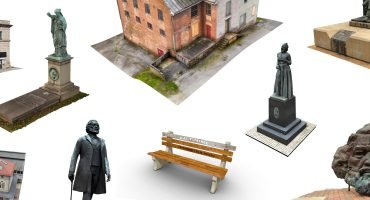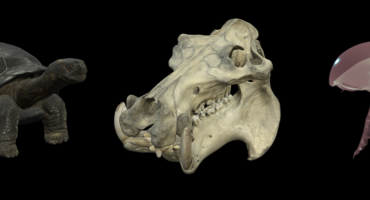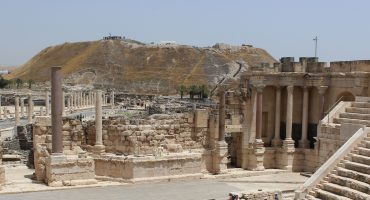My name is Marissa Dudek, and I recently graduated from James Madison University with a Bachelors of Science in Geology. I have been creating three-dimensional models of geologic features for almost four years. The models I have uploaded onto Sketchfab have been used for geoscience education, geotechnical analyses, and for the study of geology of other planets. I have greatly enjoyed my part in bringing the joy of geology to people around the world.
Geoscience Education
I started my undergraduate education at Northern Virginia Community College (NOVA), where I worked with professor Callan Bentley. I contributed to a multi-year project of building a massive, online repository of geologic imagery, known as the Mid-Atlantic Geo-Image Collection (MAGIC). We created GigaPans (interactive panoramic photos) and 3D models of geologic outcrops and hand samples, which are chunks of rock that have been broken off of larger outcrops and that can easily fit in your hand. MAGIC is a subset of the Google Earth for Onsite and Distance Education project (GEODE), which includes several educational resources, such as virtual field experiences, curated geo-image galleries, and educational games.
I developed the skill of structure-from-motion (SMF) photogrammetry through online tutorials and first-hand practice in the field. It was a little tricky in the beginning to find a technique that worked for me, and to learn what angles and how many overlapping images are needed to properly convey a surface in 3D. However, it was a quick skill to pick up, and I encourage everyone to try it themselves. We used a standard point-and-shoot camera and were able to efficiently create 3D models with the software Agisoft PhotoScan (now MetaShape). We chose Sketchfab as the site of our MAGIC 3D collection because it is a free service with an enthusiastic and growing community.
Mid-Atlantic Geo-Image Collection by Marissa Dudek on Sketchfab
The MAGIC project allows anyone with internet access to have a high resolution, in-depth view of geology from around the world. We have made several 3D printed versions of hand samples and scaled down outcrops to extend the tactility of the digital models. These printed models are used to replicate samples for easy handling, to bring outcrops into the classroom, and, most importantly, to engage disabled students and students without sufficient funding to experience geology.
After my time at NOVA, I transferred to James Madison University (JMU) where I contributed to two research projects; the first focused on geotechnical engineering using 3D models to evaluate rock slope stability, and the second focused on planetary geophysics which gave me an excuse to create 3D models of geology across our solar system.
Geotechnical Engineering
The first project I was involved in at JMU was led by Dr. Yonathan Admassu. We used 3D models to evaluate slope performance with respect to rockfall generation along highways. In other words, we looked at the probability of rockfalls occurring along major roadways. Our method was to compare time-lapse 3D models of a rock slope, find the differences between the two surfaces, and to assess the quantity of rockfall generation. We could then identify the slope’s stability and relay that information to the local Department of Transportation.
Frazier Quarry, located just down the street from JMU in Harrisonburg, VA (shown above), was kind enough to let us run a test of our method in a controlled environment. The timelapse models below were created as a proof-of-concept on how effectively our method could evaluate rock displacement. First, a 3D model was created of a large pile of limestone boulders to represent an “unaltered” surface. Rocks of varying sizes where then labeled and randomly displaced to simulate a rockfall. And then a second 3D model was created to represent the “altered” surface.
Not much difference can be seen when comparing the two models with the naked eye. However, with the software Cloud Compare, the differences in surface elevation between the two models can be easily distinguished. Negative change in red represents a loss of material, while positive change in blue represents a gain in material. False positives were found when the two models were not overlain properly, due to minor differences in the point cloud densities, shadows, and geospatial referencing with GPS coordinates.
 Differences in surface elevation between the two models (unaltered and altered) shown as negative change in red and positive change in blue. (left) Major elevation differences between the models, (right) all elevation differences shown.
Differences in surface elevation between the two models (unaltered and altered) shown as negative change in red and positive change in blue. (left) Major elevation differences between the models, (right) all elevation differences shown.We also used SFM photogrammetry to evaluate a highway rock slope’s factor of safety (FoS). The rockfall hazard rating system evaluates a rock slope’s potential for generating rockfalls from field-based data on slope geometry, discontinuity orientation, rock friction, and differences in erosion rate. Our method used SFM photogrammetry to build a 3D surface of a slope, to analyze these factors digitally.
Our study location was the previously failed Deerfield road cut in West Augusta, VA along Rt. 629. The slope failed due to a hidden fold hinge within the outcrop, which sent 3,500 cubic yards of material into the catchment ditch and across the road below. We again used Agisoft PhotoScan to render the 3D model; however, instead of a simple point-and-shoot camera that I had used previously, we employed an unmanned aerial vehicle (UAV) to cover a larger area while maintaining relatively high-resolution. The software TSLOPE was used to evaluate the composite and basal surfaces for the factor of safety calculations (see images below). A slope is stable if the FoS is greater than 1, and increasingly unstable if less than or equal to 1. The FoS of the Deerfield rock slope was found to be 0.63 ± 0.3. This information can help Departments of Transportation evaluate and prioritize slope remediation, and to maintain a digital inventory of rock slopes along highways.
- Digital 3D model of the previously failed Deerfield rock slope along Rt. 629 in West Augusta, VA
- Composite surface created with TSLOPE, incorporating rock density, cohesion, and angle of friction.
- Basal planes along which the rock slope will most likely fail used to evaluate the factor of safety.
Planetary Geology
My second research project at JMU focused on using planetary geology and geophysics with Dr. R. Shane McGary. We used a theoretical distribution of impact craters on the surface of Venus to add further constraints on the age of the crust. As this research was mostly comprised of numerical modeling in MATLAB, I wanted to use my 3D skills and the Sketchfab platform to explore planetary surfaces for fun.
NASA’s Solar System Trek, allows anyone to view the surface of the Moon, Mars, and several other terrestrial bodies in the solar system for free. I couldn’t stop my curiosity and began creating 3D models of impact craters and other significant geologic features using Trek’s 3D Model Generator.
Since graduating from JMU, I will be taking a gap year to gain more professional experience and to prepare a paper for publication. I plan on going on to graduate school to study planetary geology.
Women on Sketchfab
I have met so many inspirational and hard working women in the science community throughout my career. I would not be where I am today without the support of my professors, mentors, and peers. Geology is an increasingly diverse field, and I hope to inspire others to enjoy STEM and to experience the world with an inquisitive mind. On Sketchfab, we are providing people with the chance to see places, and experience wonderful things, around the world and across the solar system, no matter their age, sex, income, or physical abilities. I am honored to be a part of such an amazing community on Sketchfab.








